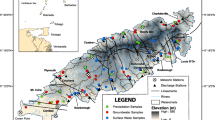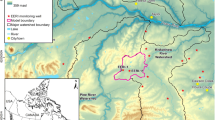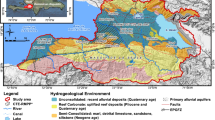Abstract
The relatively rapid stream capture of the New River basin by the Roanoke River basin provides a unique example of topographic change within a tectonically inactive environment. A previous investigation of abandoned river deposits has shown the capture of ~225 km2 of New River basin area, which has caused approximately 250 m of incision by the Roanoke River. Difference in base level elevations between the lower Roanoke to the higher New River could be the source of potential energy driving rapid incision. Significant incongruities in base level elevations at the boundaries of an aquifer can steepen the gradient and shift the groundwater divide further toward the higher elevation. If a steep groundwater gradient and expanded groundwater basin exists beneath the Roanoke River tributaries, this would suggest a groundwater control on incision and capture. This investigation incorporates average total head, measured from 18 domestic wells, and constant-head river boundary conditions into numerical models to calculate water levels and gradients between the rivers. Thermal patterns and particle tracking of spring locations were utilized to better understand flow paths in the region. Our results show the groundwater divide is shifted toward the higher elevation boundary, indicating that the groundwater basin is captured prior to surface capture. Flow pathways utilized by groundwater capture can be either diffuse or conduits; however, further work should be done to better understand travel times and flow depths.







Similar content being viewed by others
References
Anderson MP (2005) Heat as a ground water tracer. Groundwater 43(6):951–968
Bishop P (1995) Drainage rearrangement by river capture, beheading and diversion. Prog Phys Geogr 19(4):449–473
Dicken CL, Nicholson SW, Horton JD, Kinney SA, Gunther G, Foose MP, Mueller JA (2005) Preliminary integrated geologic map databases for the United States, Delaware, Maryland, New York, Pennsylvania, and Virginia. US Geological Survey Open-File Report 2005-1325
Dunne T (1980) Formation and controls of channel networks. Prog Phys Geogr 4(2):211–239
Gesch DB (2007) Digital elevation model technologies and applications. The DEM users manual. In: Maune D (ed) The national elevation dataset, 2nd edn. American Society for Photogrammetry and Remote Sensing, Bethesda, pp 99–118
Gesch D, Oimoen METER, Greenlee S, Nelson C, Steuck METER, Tyler D (2002) The national elevation dataset. Photogramm Eng Remote Sens 68(1):5–11
Hack JT (1973) Drainage adjustment in the Appalachians. Fluvial Geomorphology, pp 51–69
Harbaugh AW (2005) MODFLOW-2005, the US Geological Survey modular groundwater model—the groundwater flow process. US Geological Survey Techniques and Methods 6–A16, various p.
Harlow GE Jr, Orndorff RC, Nelms DL, Weary DJ, Moberg RM (2005) Hydrogeology and ground-water availability in the carbonate aquifer system of Frederick County, Virginia. US Department of the Interior, US Geological Survey Scientific Investigations Report 2005-5161, pp 005–5161
Kafri U (1970) Factors controlling the location of the groundwater divide in northern Israel. J Hydrol 11:22–29
Luhmann AJ, Covington MD, Peters AJ, Alexander SC, Anger CT, Green JA, Runkel AC, Alexander EC Jr (2011) Classification of thermal patterns at karst springs and cave streams. Groundwater 49(3):324–335
Manga METER (2002) Using springs to study groundwater flow and active geologic processes. Annu Rev Earth Planet Sci 29:201–228
Menne MJ, Durre I, Korzeniewski B, McNeal S, Thomas K, Yin X, Anthony S, Ray R, Vose RS, Gleason, BE, Houston TG (2012) Global historical climatology network—daily (GHCN-Daily), Version 3.12. NOAA National Climatic Data Center. doi:10.7289/V5D21VHZ. Accessed July 2014
Menne MJ, Durre I, Vose RS, Gleason BE, Houston TG (2012) An overview of the global historical climatology network-daily database. J Atmos Ocean Technol 29:897–910
Poeter EP, Hill MC, Banta ER, Mehl S, Christensen S (2005) UCODE_2005 and six other computer codes for universal sensitivity analysis, calibration, and uncertainty evaluation. US Geological Survey Techniques and Methods 6–A11:299
Pollock DW (2012) User guide for MODPATH Version 6—a particle-tracking model for MODFLOW. US Geological Survey Techniques and Methods 6–A41:58
Prince PS, Spotila JA, Henika WS (2010) New physical evidence of the role of stream capture in active retreat of the Blue Ridge escarpment, southern Appalachians. Geomorphology 123:305–319
Prince PS, Spotila JA, Henika WS (2011) Stream capture as driver of transient landscape evolution in a tectonically quiescent setting. Geology 39(9):823–826
Seaton WJ, Burbey TJ (2005) Influence of ancient thrust faults on the hydrogeology of the Blue Ridge Province. Groundwater 43(3):301–313
Shapiro AM, Hsieh PA (1998) How good are estimates of transmissivity from slug tests in fractured rock? Groundwater 36(1):37–48
Spotila JA, Bank GC, Reiners PW, Naeser CW, Naeser ND, Henika BS (2004) Origin of the Blue Ridge escarpment along the passive margin of the Eastern North America. Basin Res 16:41–63
Swain LA, Mesko TO, Hollyday EF (2004) Summary of the hydrogeology of the valley and ridge, Blue Ridge and piedmont physiographic provinces in the Eastern United States. US Geological Survey Professional Paper 1442–A:23
US Geological Survey (2010) National Hydrography Dataset: the United States Geological Survey
Welch LA, Allen DM (2014) Hydraulic conductivity characteristics in mountains and implications for conceptualizing bedrock groundwater flow. Hydrogeol J 22:1003–1026
Yager RM, Voss CI, Southworth S (2009) Comparison of alternative representations of hydraulic-conductivity anisotropy in folded fracture-sedimentary rock: modeling groundwater flow in the Shenandoah Valley (USA). Hydrogeol J 17:1111–1131
Yechiel Y, Kafri U, Wollman E, Lyakovky V (2009) The effect of base level changes and geological structures on the location of the groundwater divide, as exhibited in the hydrological system between the Dead Sea and the Mediterranean Sea. J Hydrol 378:218–229
Acknowledgments
We would like to thank the Virginia Tech Geology Department and the Leo and Melva Harris Scholarship fund for funding this project. We would also like to thank well owners and spring owners (Town of Christiansburg, Town of Blacksburg, the Blacksburg Parks and Recreation Department) for allowing us to utilize their wells and spring locations for this research.
Conflicts of interest
The authors state that they have no conflict of interest.
Author information
Authors and Affiliations
Corresponding author
Rights and permissions
About this article
Cite this article
Bloxom, L.F., Burbey, T.J. Determination of the location of the groundwater divide and nature of groundwater flow paths within a region of active stream capture; the New River watershed, Virginia, USA. Environ Earth Sci 74, 2687–2699 (2015). https://doi.org/10.1007/s12665-015-4290-1
Received:
Accepted:
Published:
Issue Date:
DOI: https://doi.org/10.1007/s12665-015-4290-1




